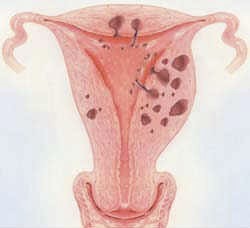
What is Adenomyosis?
Adenomyosis is when there is endometrial tissue that grows into the uterus. The uterus is a muscle and the mucous membrane which thickens during the menstrual cycle is referred to as the endometrium. Endometrial tissue grows local in one small site of the uterus called focal adenomyosis or it can be more extensive resulting in a mass in the uterus called an adenomyoma. Another type of adenomyosis is called diffuse adenomyosis which spreads throughout the uterus and is more extensive. Adenomyosis can form because of endometriosis infiltrating up into the cervix and uterus or vaginal injury causing inflammation, macrophages and cytokines into the myometrium. This results in tissue growth in the area. There may also be a thickening of the wall of the uterus. Adendomyosis is therefore painful. It causes excessive bleeding during menstruation, clotting, pelvic pain, leg pain, low back pain, and can be debilitating. Other symptoms may include prolonged menstrual cramps, longer than normal menses, painful intercourse, and abdominal pain. Digestion can be affected such as causing constipation or diarrhea. The bladder and its function can also be impacted such as painful urination, bleeding with urination, urine retention, or overactive bladder. Myofascial trigger points in the abdomino-pelvic wall, pelvic floor muscles, and hip muscles may need to be assessed and addressed via physical therapy. Overactive (or hypertonic) pelvic floor muscle dysfunction may be found on evaluation. Treatment may include surgery, pain management, and physical therapy. Not all classifications of adenomyosis require a hysterectomy yet a surgical option would be discussed by your gynecologist. Medication for pain relief is another more conservative treatment option. Physical therapy is an alternative option for pain relief and symptom relief.
How can Pamela Morrison Physical Therapy Help with Adenomyosis?
A full orthopedic, viscera mobility, and pelvic floor muscle exam occurs to determine what needs to be realigned and mobilized using advanced manual therapies or addressed with pain modalities. Soft tissue mobilization (massage) and visceral manipulation will help the abdominal wall muscles and pelvic region myofascial trigger points, uterus, bladder, rectum, and digestive organs feel better. Myofascial release can help break up soft tissue myofascial adhesions. Restoring organ mobility and motility helps overcome pathophysiology (impaired physiology, pain) caused by adenomyosis and restores normal physiology. This may also improve menstrual cramps or prolonged menstruation. Joint mobilization will help the spine, sacrum, and coccyx move better and remedy low back pain. Pain modalities such as moist heat, cold laser, electrical stimulation, and ultrasound can all help decrease pain levels of the abdomino-pelvic and low back region. Pelvic floor muscle rehabilitation including soft tissue mobilization, down-training, and sEMG biofeedback may help resolve painful intercourse and pelvic pain. Diet and supplements will be reviewed. We have great success helping women with adenomyosis.


